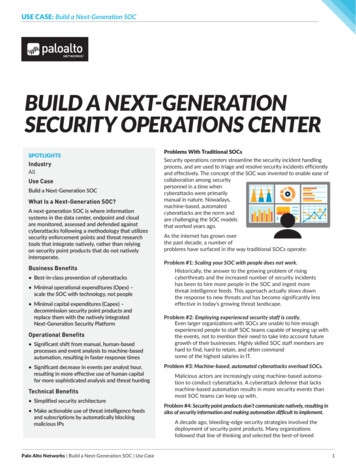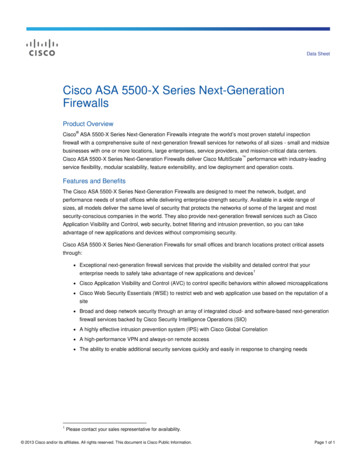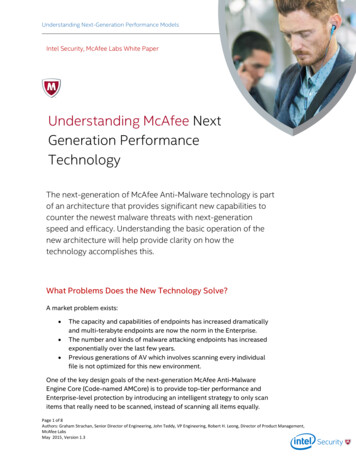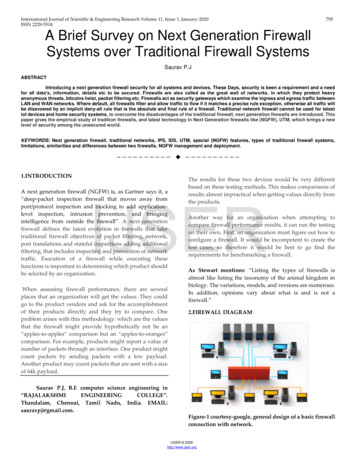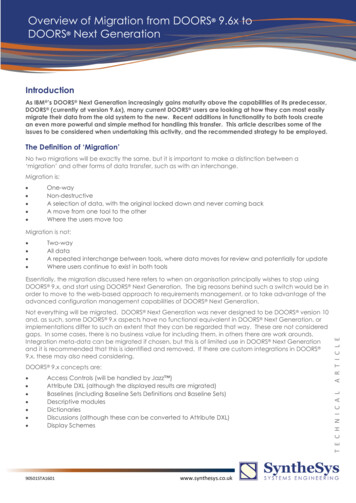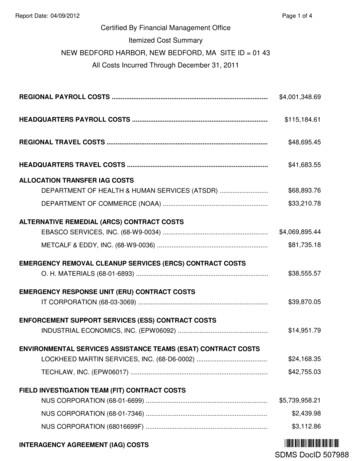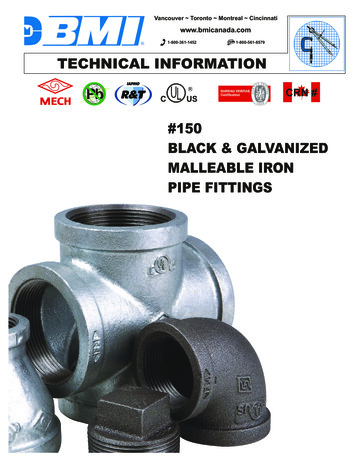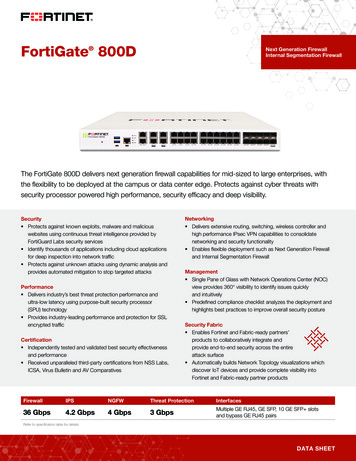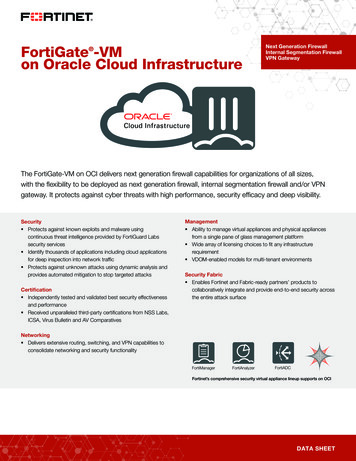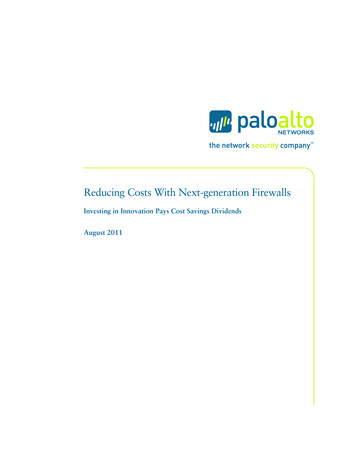
Transcription
Reducing Costs With Next-generation FirewallsInvesting in Innovation Pays Cost Savings DividendsAugust 2011
Palo Alto Networks: Reducing Costs With Next-generation FirewallsTable of ContentsExecutive Summary3IT Security: Regain Visibility and Control While Reducing Costs3Legacy Firewalls are Ineffective in Today’s Application and Threat Landscape3Firewall “Helpers” Lead to Complex and Costly Appliance Sprawl3Financial Climate Means That IT Must Reduce Costs4Band-Aids Aren’t The Answer – Address the Problem: Fix the Firewall4Investing in Innovation and Reducing Costs With Palo Alto Networks4Capital Expenditures: Next-generation Firewalls Enable Consolidation4Operational Expenses: Reduce Support and Subscriptions with Palo Alto Networks4Operational Expenses: Device Consolidation Helps Green IT and Power Consumption4Customer Examples Show Savings5Customer Example #1: Large Financial Services Organization5Customer Example #2: Global Manufacturer6Customer Example #3: City Government and Schools7Investing in Innovation With Palo Alto Networks Saves Money8Appendix: Reduce Cost, but Maintain Enterprise Performance9PAGE 2
Palo Alto Networks: Reducing Costs With Next-generation FirewallsExecutive SummaryFor enterprise IT security organizations, the evolution of applications and threats, coupled with the stagnationof traditional network security technology has resulted in a loss of visibility and control. Despite efforts toregain visibility and control by adding more security appliances, most organizations remain stymied – unacceptably.In today’s economic climate, however, any further increase in cost and complexity is similarly unacceptable.Some leading enterprises, however, have found that investing in innovation, and bucking the trend of seeminglynever-ending appliance sprawl in network security can result in the restoration of visibility and control, andsubstantial reduction in cost of ownership of security infrastructure. This paper examines three differentorganizations, the legacy infrastructure they replaced, the Palo Alto Networks next-generation firewalls theydeployed, and the substantial savings they realized – cutting both capital and operations costs by an averageof 50%.IT Security: Regain Visibility and Control While Reducing CostsContemporary IT security organizations face a host of challenges - some of them understood (rapidlyevolving threats, organizational issues, compliance), and others brand new (rapidly evolving applications,employee cultural changes, and the current economic climate). More than ever, it is incumbent on IT securityto address two seemingly conflicting mandates:nnRegain visibility and control of enterprise networks in the face of evasive, but often necessaryapplications and modern, sophisticated threatsGiven the economic climate – reduce costsWhile on first blush, these requirements seem to pull organizations in different directions; this paper willdemonstrate how organizations can, by investing in innovation, meet these requirements with a commoninitiative.Legacy Firewalls are Ineffective in Today’s Application and Threat LandscapeTo comply with most regulations, business covenants, and auditor findings, most organizations have tounderstand and control the applications, user behavior, and content on the enterprise network. Unfortunately,modern applications, users, and content have evolved beyond the legacy set of network-based securityinfrastructure – and can easily circumvent most firewalls and other port- and IP address-based networksecurity devices. Using encryption, proxies, port-hopping, or other evasive techniques, or tunneling overports 80 or 443, most applications and threats easily knife through enterprise network security defenses.With over 2/3 of enterprise Internet traffic moving over port 80, it has become clear to most enterprise informationsecurity professionals that the old mapping of applications to ports is no longer relevant. Thus making thefirewall largely useless, despite the firewall’s position in the network and its long history of ubiquitous adoption.Firewall “Helpers” Lead to Complex and Costly Appliance SprawlTo the chagrin of many IT professionals, the industry’s traditional response to new applications and threatshas been to add more appliances – each “helping” the firewall with a piece of the network security function.This unsustainable approach has long proven complex and costly, and now appears to be broken – since thesefirewall helpers either can’t see all of the traffic, rely on the same port- and protocol-based traffic classificationthat has failed the legacy firewall, or proxy a very limited number of applications (a dozen instead of hundredsor thousands). Given that enterprises had little choice, most have adopted an array of firewall helpers – resultingin a network security infrastructure that is expensive, difficult to manage, and increasingly ineffective atcontrolling application or the threats that applications might carry – characteristics proving unacceptable toenterprises today.PAGE 3
Palo Alto Networks: Reducing Costs With Next-generation FirewallsFinancial Climate Means That IT Must Reduce CostsIn today’s economical environment, many IT groups are struggling to fund operations. Budgetary pressuresare extreme, cost-saving mandates are commonplace, and green IT initiatives continue. Given this climate,IT security staffs must innovate or risk obsolescence – incremental changes to ineffective infrastructure can’tsolve these issues.Band-Aids Aren’t The Answer – Address the Problem: Fix the FirewallThe firewall is the network security foundation for nearly every enterprise – with good reason: the firewall isin-line, sees all traffic, and thus is in a unique position to enforce control. It also demarcates the trust boundary.The problem, as stated above, is that legacy firewall implementations are not effective in today’s applicationand threat environment, and “helpers” don’t help. Next-generation firewalls from Palo Alto Networks fix thefirewall, enabling enterprises to regain visibility and control over the applications, users, and content on theirnetworks – and greatly reduce the number of security appliances that they have to maintain.Investing in Innovation and Reducing Costs With Palo Alto NetworksBy “fixing the firewall,” with Palo Alto Networks next-generation firewalls, organizations can regain thevisibility and control that they have been lacking, and cut down on the expensive and complex securityappliance sprawl they’ve been forced into over the last decade. Cost savings come in two major areas: capitalexpenditures, and operational expenses.Capital Expenditures: Next-generation Firewalls Enable ConsolidationCapital expenditures are relatively well understood – one device is typically cheaper than three. The issue whenmodeling security device consolidation is the timing of those purchases. Very few enterprises decommissionmultiple types of devices across the enterprise at the same time. The scope and size of these costs, however, evenbeing mindful of phased purchases and depreciation schedules, merit serious consideration – since by consolidatingsecurity devices utilizing the budget for one type of device might obviate the need for an additional purchasein the future. The traditional issue with consolidation – performance – isn’t an issue with Palo Alto Networksnext-generation firewalls, because of their purpose-built design (see the Appendix for more detail on consolidationand performance).Operational Expenses: Reduce Support and Subscriptions with Palo Alto NetworksLooking at “hard” operational expenses, there are 3 or 4 major categories: support/maintenance contracts,URL filtering subscriptions, threat prevention/IPS subscriptions (in not captured in IPS device maintenance/support), and power/HVAC. There are other “soft” operations costs that can be significant in a case forconsolidation – IT staff productivity, end user productivity, help desk calls, training, vendor management –but for maximum credibility, these costs are often better characterized rather than counted. Rack space is apotential exception, as some organizations have done enough analysis and can characterize all of their datacenter costs per unit of rack space (real estate, power, cooling, management, etc.).Operational Expenses: Device Consolidation Helps Green IT and Power ConsumptionRegarding power and data center HVAC, many organizations have “green” efforts, attempting to reduce energyuse and the amount of waste they generate. Given the amount of energy used by a typical data center, IT isoften called upon to reduce the amount of power consumed by IT infrastructure and data center cooling.Effectively consolidating security devices can offer substantial energy savings – both directly (i.e., the powerconsumed by the security device) and indirectly (i.e., the power consumed by the data center cooling systemto cool the device). A good rule of thumb is a watt of power consumed is a watt of power needed for cooling.Furthermore, fewer devices means less waste – combined with reduced energy use, makes a compelling“green” argument for effective security device consolidation.PAGE 4
Palo Alto Networks: Reducing Costs With Next-generation FirewallsCustomer Examples Show SavingsPerhaps the best way to understand potential savings is by looking at a few examples. Here are three realworld examples – a very large organization, a medium-sized organization, and a smaller organization – theirissues, expenses, and how – using Palo Alto Networks next-generation firewalls – they were able to regainvisibility and control of their networks, while significantly reducing complexity and costs.Customer Example #1: Large Financial Services OrganizationSaving 331K/year with Palo Alto Networks: Using Palo Alto Networks, a large ( 100 billion annualrevenue), multinational financial services organization is undergoing an enterprise network security deviceconsolidation project – and will save 331K/year in network security operations costs – at one location.Legacy Deployment – Lots of Sprawl: Examining the legacy deployment at that location (mid-Atlantic, US,serving 5000 users), the IT organization maintained Cisco firewalls, Sourcefire IPS appliances, SecureComputing Webwasher appliances, and Blue Coat proxy appliances. The sheer number of security appliancesdictates significant additional infrastructure just to accommodate their connectivity – including a dedicatedswitch and a pair of F5 Local Traffic Managers.Palo Alto Networks – Greener and Faster: Given the state of the financial industry, operational cost reductionsare welcome. Furthermore, “going green” has a significant value for many organizations (including thisone), both internally and externally. In just one data center, this customer is showing a reduction in powerand HVAC costs of nearly 40K annually – a savings of 90%. Palo Alto Networks could show substantialfunctional consolidation (firewall, URL filtering, threat prevention), and could also reduce the overallnumber of firewalls due to the PA-4000 Series’ superior performance and increased port density. Furthermore,the PA-4000 Series’ application visibility and control gave the IT organization the tools they needed tobetter manage application use on their network – safely enabling desirable applications, while preventingthe use of undesirable applications.Large OrganizationLegacyPalo Alto NetworksSavingsCapital Costs 2,424,940.00 480,000.00 1,944,940.00Annual Operations CostsSupport ContractsURL FilteringThreat PreventionPower/HVACTotal Annual Ops Costs 424,785.60 40,000.00n/a 44,106.30 508,891.90 76,800.00 48,000.00 48,000.00 4,403.20 177,203.20 331,688.70Legacy Equipment:Firewall: 12x Cisco ASA 5580, IPS: 2x Sourcefire3D9800, URL filtering/proxy: 6x Secure ComputingWebwasher 1900E 5x Blue Coat ProxySG 8100, Trafficmanagement: 2x F5 6800 Local Traffic ManagerPAGE 5Palo Alto Networks Equipment:10x PA-4050
Palo Alto Networks: Reducing Costs With Next-generation FirewallsCustomer Example #2: Global ManufacturerSaving 147K Per Location in Capital Costs With Palo Alto Networks: With Palo Alto Networks nextgeneration firewalls, this 30-site, 1B global manufacturer has reduced its annual remote site networksecurity operations costs by 35%.Legacy Standard Security Infrastructure Was Expensive: This customer’s standard security rack at eachlocation included Cisco ASA firewalls, Tipping Point IPS, and a Microsoft ISA Server running on Dellhardware. The expenses surrounding the customization and upkeep of the ISA Server coupled with thelimited capabilities of the Cisco firewalls prompted the IT group to look to Palo Alto Networks to simplifythe security infrastructure – and in doing so, give control of the network back to the IT group.Palo Alto Networks is the New Standard: The visibility, control, and cost savings were significant enoughthat the organization quickly deployed across 3 sites, and declared Palo Alto Networks next-generationfirewalls as the standard deployment for all sites going forward. Looking at just the 3 deployed sites, theIT group was able to show a reduction in capital costs of over 117,000. Similarly, across the 3 deployedlocations, the IT group was able to show annual savings of nearly 20,000. Once deployed across theremaining 27 sites, this will represent an enormous annual cost reduction.Medium-sized OrganizationLegacyPalo Alto NetworksSavingsCapital Costs 213,555.00 96,000.00 117,555.00Annual Operations CostsSupport ContractsURL FilteringThreat PreventionPower/HVACTotal Annual Ops Costs 34,168.80 15,000.00n/a 6,902.02 56,070.82 15,360.00 9,600.00 9,600.00 1981.44 36,541.44 19,529.38Legacy Equipment (for each of 3 locations):Firewall: 2x Cisco ASA 5520, IPS: 1x TippingPoint600E, URL filtering/proxy: 1x Dell 2950 and MicrosoftISA Server – EnterprisePAGE 6Palo Alto Networks Equipment (for each of3 locations):2x PA-2050
Palo Alto Networks: Reducing Costs With Next-generation FirewallsCustomer Example #3: City Government and SchoolsCut Operational Expenses by 64%: The last example is a smaller organization, a city government and schoolsystem on the East Coast of the United States, who was able to show operations cost reduction of 64%.Legacy Infrastructure Couldn’t Perform: This organization was using Watchguard firewall/UTM devicesand St. Bernard iPrism filtering appliances. Unfortunately, the city employees and school staff and studentswere able to use less than 10% of their Internet bandwidth due to the poor performance of their securityinfrastructure. Additionally, the fees associated with URL filtering and maintenance subscriptions werevery high. Finally, and most importantly, students and staff easily bypassed these network security controlsusing proxies, encrypted applications (like Skype), and tunneling applications like UltraSurf and TOR.Palo Alto Networks Restores Visibility, Control, and Performance: Replacing the end-of-life and poorlyperforming Watchguard and St. Bernard infrastructure saved the city thousands of dollars per year. The ITstaff was able to present a compelling case for the PA-2050 next-generation firewall – showing a capitalcost savings of nearly 7000 over replacing the 20,000 legacy infrastructure. Perhaps more importantly,by consolidating existing functions, and adding the application visibility and control that the city needed,IT staff was able to reduce network security operations costs from over 25,000 to just 9,200 per year– a savings of over 16,000/year. Functionally, the city was able to see and control evasive applications,comply with federal and state regulations regarding school technology use, and safely enable a widevariety of Internet applications for staff.Small OrganizationLegacyPalo Alto NetworksSavingsCapital Costs 22,957.00 16,000.00 6,957.00Annual Operations CostsSupport ContractsURL FilteringThreat PreventionPower/HVACTotal Annual Ops Costs 3,673.12 20,000n/a 2,008.96 25,682.28 2,560.00 3,200.00 3,200.00 330.24 9,290.24 16,391.84Legacy Equipment:Firewall/UTM: Watchguard Firebox x8500e-F, URLfiltering – St. Bernard iPrism 50h (M11000)PAGE 7Palo Alto Networks Equipment:1x PA-2050
Palo Alto Networks: Reducing Costs With Next-generation FirewallsInvesting in Innovation With Palo Alto Networks Saves MoneyIn all three cases, the savings in both capital costs and operations costs were substantial. On average, thethree organizations examined in this paper reduced their capital budgets by more than 50%, and cut theirannual operations costs by a similar number. Granted, there are big differences across these examples, butmany Palo Alto Networks customers can easily demonstrate a rapid return on their investment – coveringthe upfront cost of the solution with the reduction in operations costs in the first year. Regaining control ofthe applications, users, and content on the network was of equal importance to the IT staffs in the enterprisecustomers examined in this paper, but demonstrating the cost advantages enabled these projects to moveforward quickly – even in a tough economic climate. In brief summary:nnnSave 30%-80% in Capital Expenditures. In all three examples, reducing the number of security appliancesresulted in substantial reduction of capital expenditures – from 30% in our “small” example (we onlyreplaced 2 boxes), to 80% in our “large” example.Save 40%-65% in Operational Expenses. In all three examples, hard operations costs went downsignificantly – what organizations spent on support/maintenance contracts, URL filtering subscriptions,and power was reduced: from 35% in our “medium” example to 65% in our “large” example.Save on “Soft” Costs Too. We didn’t attempt to quantify “soft” costs, which, while significant, are difficultto quantify and often undermine the impact of a cost analysis. In our examples, the medium and smallorganizations reported substantial soft costs savings. For the manufacturer, deployment and integrationefforts were greatly reduced, resulting in demonstrable savings. In our small example, the customer citeda reduction in the time it took to find and resolve security problems – often before they resulted in a helpdesk call, for which they could easily demonstrate savings.The bottom line for many organizations is that while they have security and compliance needs that must bemet, very few projects that don’t demonstrate significant cost savings will move forward in today’s economicclimate. For Palo Alto Networks customers, investing in innovation with next-generation firewalls has helpedthem regain visibility and control, and has enabled substantial cost savings – a rare combination of benefitsthat has resulted in increased stature within their organizations.PAGE 8
Palo Alto Networks: Reducing Costs With Next-generation FirewallsAppendix: Reduce Cost, but Maintain Enterprise PerformanceAs previously mentioned, most enterprises today have a network security infrastructure that is less and lesseffective. This ineffectiveness, coupled with the spiraling costs of maintaining this array of security devices,has pushed many organizations to attempt security device consolidation. Unfortunately, most enterprise networksecurity device consolidation efforts backfire – poor performance of consolidated devices quickly forces ITsecurity teams to turn off security functions to enable business traffic to flow. This is often because typicalunified threat management devices are built by grafting various acquired and open source security functionsonto a legacy port-based firewall running on PC-based hardware. As an aside, UTM devices still don’t offeradditional visibility and control beyond the usual port/protocol/IP address-based control of legacy infrastructure– just consolidated hardware.Palo Alto Networks’ next-generation firewalls can consolidate many of the existing security functions, andenables IT organizations to regain visibility and control as mentioned previously. The PA-5000, PA-4000 andPA-2000 Series and the PA-500 platforms can deliver all of these functions with enterprise performance –because they’ve been designed from the ground up to do so. In building a next-generation firewall that focuseson applications, users, and content, Palo Alto Networks had to start with a clean sheet of paper. This enabledthe designers of Palo Alto Networks next-generation firewalls to solve many of the problems associated withprevious device consolidation attempts.First, Palo Alto Networks engineers addressed the path that traffic takes through the security infrastructure.In legacy network security infrastructure, traffic flows through several security devices, each with it’s ownnetworking engine, classification engine, pattern matching engine, and policy engine. This duplication ofeffort is not only inefficient, but slow. Even with UTM devices, there is often a great deal of redundancy.Palo Alto Networks next-generation firewalls utilize a single pass architecture, with traffic flowing through asingle networking component, a single application classification engine, a user classification capability, and asingle content/pattern matching engine – resulting in the ability to see and enforce policy control acrossapplications, users, and content (including threats) – without slowing traffic.Second, Palo Alto Networks addressed hardware – using principles commonly employed when designingnetworking devices. Separation of data and control planes means that heavy utilization of one doesn’t negativelyimpact the other. The control plane has it’s own CPU, RAM, and disk. Additionally, dedicated, specializedprocessing and memory for networking, security, and content analysis – all connected via a high-speed data plane(up to 20Gbps on the PA-5000 Series) means that traffic won’t bog down. Figure 1 is a graphical representationof both hardware and software: Palo Alto Networks’ single pass, parallel processing architecture.Figure 1: Palo Alto Networks Single Pass, Parallel Processing ArchitecturePAGE 9
Palo Alto Networks: Reducing Costs With Next-generation Firewalls3300 Olcott StreetSanta Clara, CA 95054Main:Sales:Support: 1.408.573.4000 1.866.320.4788 1.866.898.9087www.paloaltonetworks.comCopyright 2011, Palo Alto Networks, Inc. All rights reserved. Palo Alto Networks,the Palo Alto Networks Logo, PAN-OS, App-ID and Panorama are trademarks ofPalo Alto Networks, Inc. All specifications are subject to change without notice.Palo Alto Networks assumes no responsibility for any inaccuracies in this documentor for any obligation to update information in this document. Palo Alto Networksreserves the right to change, modify, transfer, or otherwise revise this publicationwithout notice. PAN WP RC 082911
Palo Alto Networks: Reducing Costs With Next-generation Firewalls PAGE 2 Table of Contents Executive Summary 3 IT Security: Regain Visibility and Control While Reducing Costs 3 Legacy Firewalls are Ineffective in Today's Application and Threat Landscape 3 Firewall "Helpers" Lead to Complex and Costly Appliance Sprawl 3 Financial Climate Means That IT Must Reduce Costs 4
